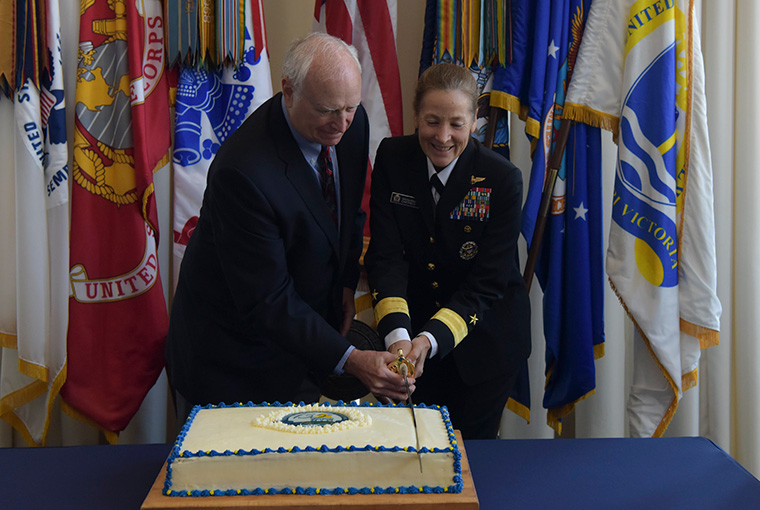U.S. Naval War College Kicks off 135th Anniversary Celebration

NEWPORT, R.I. -- The U.S. Naval War College kicked off its 135th anniversary year Oct. 7 with a visit by four past presidents of the college, a group whose experience spans nearly two decades of the institution.
“For 135 years, this college has served as the intellectual nexus for the U.S. Navy through times of peace and times of conflict,” said Rear Adm. Shoshana S. Chatfield, college president.
“Its graduates have worn the cloth of the nation with honor, courage and commitment. We faithfully remember and honor those who have paid the ultimate sacrifice and recognize those exceptional alumni who have gone on to hold the highest posts of military leadership,” she said.
“Our contribution to strategy development and war-gaming – essential to waging and winning past conflicts – is no less relevant today,” Chatfield said. “We remain on the cutting edge of strategic thought across warfighting domains.”
The visitors were Vice Adm. Gardner Howe, president from 2014 to 2016; retired Vice Adm. John Christenson, president from 2011 to 2013; retired Vice Adm. Rod Rempt, president from 2001 to 2003; and retired Rear Adm. Jim Stark, president from 1995 to 1998.
Rempt, the college’s 49 president, credited the college with long providing an academic and analytical underpinning for U.S. policy and strategy.
“The War College educates our future leaders and helps define our future Navy,” Rempt said while on campus. “Plus it provides a unique and impactful connection between future leaders of the U.S. and our allies and friends. It makes a huge difference in peace and war.”
Christenson said that being a student on campus forever changed how he thinks and understands the world. Returning as the college’s 53 president, he said, changed the course of his life. After Newport, Christenson went on to serve as deputy U.S. military representative to the NATO Military Committee and later as U.S. European Command chief of staff.
“The international students and their families here opened our eyes and our hearts to just how important those relationships are to sea power,” Christenson said during his visit.
Founded in 1884 as an institution with mostly summer courses, the Naval War College has grown from that first small building on the edge of Narragansett Bay.
The college was championed by a giant of the early Navy, Rear Adm. Stephen B. Luce, whose goal was increasing both the Navy’s size and its professionalism. Luce, the college’s first president, saw a need for an institution that would “teach officers the science of their own profession, the science of war.”
The college is now a higher-learning campus with 375 faculty and more than 300 staff members, serving roughly 600 in-residence graduate students and more than 1,000 distance-education students each year.
The institution’s world-class faculty teaches on topics of national security policy and defense strategy, in addition to leadership and ethics, international law of the sea and maritime history.
The college has expanded on its historic role as a center for maritime war gaming by adding information warfare to its research expertise. Faculty members also teach and consult in the fleet.
In 135 years, the college has graduated more than 50,000 students, including 29 Medal of Honor recipients, three astronauts, 27 U.S. service chiefs and more than 4,700 international officers, of whom nearly half became flag officers in their nations.
Celebrating this anniversary is a chance to acknowledge the long stretch of the institution’s influence and history, said professor John Jackson, a retired Navy captain who has been on the college staff on and off since 1980.
“It’s a pretty remarkable timeline. There are not a lot of organizations that have been in that business that long. It’s an opportunity to pause and reflect on what we’ve done for these many years,” said Jackson, who teaches in the College of Distance Education.
“The college is the place the Navy turns to think about new ideas and think about the history and heritage of the service,” he said. “It’s interesting that it’s both sides – we both look back at our history and then look forward to what the future can be.”
The college's longest continuously serving faculty member, professor Charles Chadbourn, began teaching here in 1974 – the era when Vice Adm. Stansfield Turner was sent to Newport as president to reinvigorate the curriculum for the modern Navy.
"Stansfield Turner turned this place upside down with his educational reforms in the early 1970s,” said Chadbourn, who still teaches strategy and policy in the College of Distance Education.
“What has not changed during my years at the college, however, are the three pillars which give this institution its unique character: a strong faculty, dedicated students and a demanding curriculum,” he said.
Monday’s cake cutting was only the first of several anniversary acknowledgements planned throughout the academic year.
Additionally, Professor Emeritus John Hattendorf is updating “Sailors and Scholars,” the book he co-authored in 1984 on the first 100 years of the Naval War College. The second volume will look at the college through 2009, the 125 anniversary.
Hattendorf has watched the college grow both physically and thematically in its second century.
“We’ve added colleges, such as the College of Leadership and Ethics. We’ve expanded, and the size of the faculty has grown,” said Hattendorf, who first joined the college staff in 1972 as the then-president’s speech writer and a faculty member in the Strategy and Policy Department.
The 1986 Goldwater-Nichols Act created a demand for military higher education by requiring that officers complete graduate-level professional military coursework to be eligible for the flag and general officer level.
In 1990, the college became accredited to award the Master of Arts degree. Soon after, it became accredited by the chairman of the Joint Chiefs of Staff to offer professional military education that allows graduates to go on to serve on joint staffs.
The campus grew to accommodate more programs, faculty members and students. The college completed McCarty Little Hall in 1999 as a new high-tech home for the War Gaming Department.
“The kinds of research we are doing – war gaming, the Stockton Center for International Law, the establishment of the China and Russia maritime studies institutes, the College of Maritime Operational Warfare and the College of Leadership and Ethics – all of these are great additions to what the college was before. The academic rigor is much improved,” said Hattendorf, who is the namesake for the college's John B. Hattendorf Center for Maritime Historical Research.
Hattendorf credited the late Vice Adm. James Stockdale, college president from 1977 to 1982, for focusing the institution on the subject of leadership and ethics. Stockdale, a prisoner of war in North Vietnam, was awarded the Medal of Honor for his heroism and leadership while senior officer in the so-called Hanoi Hilton prison camp.
“The emphasis on ethics starts with Admiral Stockdale. He began to teach that here,” Hattendorf said.
“Then, following the Nixon resignation, regulations for ethics were put in for government officials and military officers,” he said.
“All of that has added up to research and exploration of these areas, and to trying to understand leadership at a higher level. How does an admiral provide leadership? What do you need to lead at the strategic and operational level, rather than just shipboard?”
Looking ahead, in its 135 year, the Naval War College is poised to hold an estimated 15 academic conferences, more than 200 campus lectures and as many as eight war games on behalf of the Navy and the U.S. Department of Defense.
“I’m honored to celebrate this day with four past presidents of the college,” Chatfield said. “This marvelous institution has served the nation with distinction. I am indeed honored to be its 57 president.”

